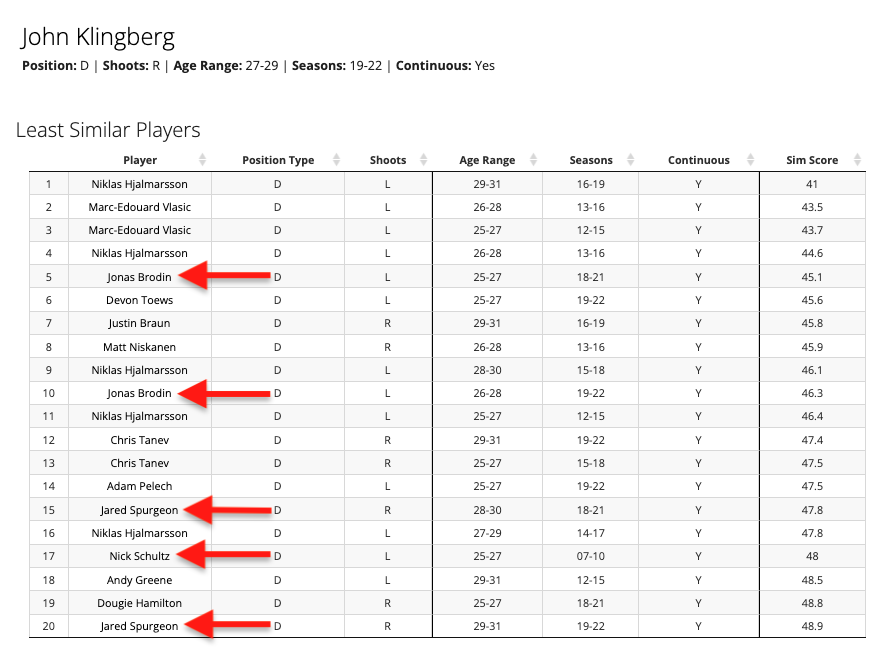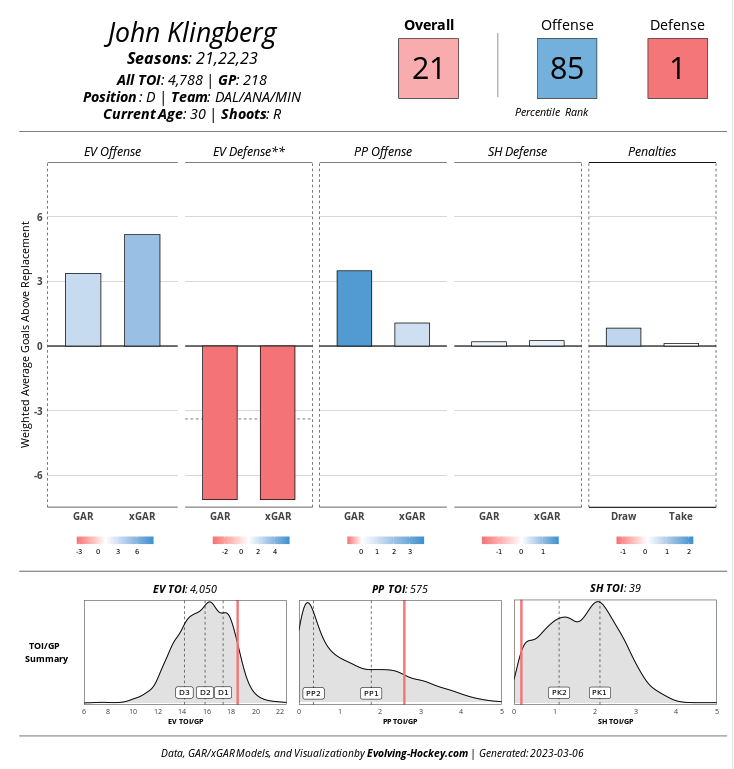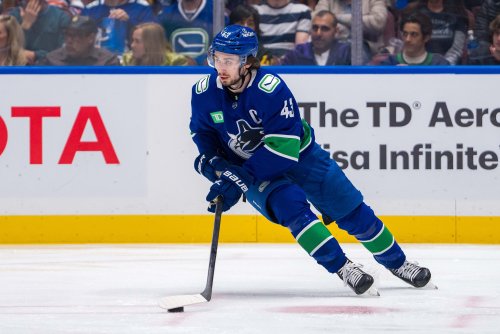
When you look at John Klingberg's Most Similar Players (shout-out to Evolving Hockey for their great Skater Similarity tool), you see a lot of recognizable defensemen. Torey Krug, James Wisniewski, Keith Yandle, and Tyson Barrie make frequent appearances.
What do they have in common? Those players are (or were) all decidedly "one-way defensemen," and their one way is the fun way. Moving the puck, pushing the pace, and running the power play are the foundation of their games. As for the rest of it? Well, it's more polite to just focus on the offense.
If that sounds like the polar opposite of almost every defenseman the Minnesota Wild have ever had, you're not wrong. In fact, the Skater Similarity tool also spits out the least similar players to Klingberg. Who's on that list?
Oh, hi there, Jonas Brodin, Jared Spurgeon, and Nick Schultz.

When you think Wild defensemen, you think of those three. Their careers cover nearly the entirety of the Minnesota Wild's existence. Marian Gaborik was their first-ever draft pick. But it was Schultz, their second, who defined the defensive, slow-paced way the franchise would play.
The Wild only went through their inaugural season without Schultz. By their second year as a franchise, Schultz was a mainstay in the lineup. Once Chuck Fletcher traded Schultz in 2012, after a decade and 743 games, he had two more to replace him in Spurgeon and Brodin, who are on the roster today.
Sure, the Wild would occasionally flirt with Brent Burns or Marek Zidlicky, and have even had Matt Dumba in the organization for a decade. But it's Schultz, Brodin, Spurgeon, and Ryan Suter's style that takes over.
Buying teams can do two things at the trade deadline. They can either get help in much-needed areas, or they can double down on what they do well. In getting Klingberg, they kind of did both.
The Wild got forward depth to try to bolster their forward group. Swapping out Jordan Greenway for Marcus Johansson, Oskar Sundqvist, and eventually, Gustav Nyquist at least theoretically boosts their depth.
However, none of them move the needle like the big fish like Timo Meier, Brock Boeser, Vladimir Tarasenko, or Tyler Bertuzzi.
So, the Wild took their big swing in the area where they're pretty well-set in at: defense. Klingberg came cheap, costing a fourth-round pick, long-shot prospect Nikita Nesterenko, and AHL veteran Andrej Sustr. But among everyone on the Wild roster, only Kirill Kaprizov and Marc-Andre Fleury have had a better claim to being a Premier NHL player than Klingberg had.
During his tenure in Dallas, from ages 22 to 29, Klingberg was one of the best offensive defensemen in the league. Here are the leaders in points per game for that age group since the 2003-04 lockout (minimum 300 games):
- Erik Karlsson, 0.87
- Victor Hedman, 0.74
- Kris Letang, 0.73
- Mike Green, 0.71
- Roman Josi, JOHN KLINGBERG, 0.68
Just look at the Norris Trophy winners in that time that don't hit that level. P.K. Subban (0.65) is slightly behind, and John Carlson (0.62) is a bit further. Drop down further, and you see Burns (0.57), Drew Doughty (0.56), and Duncan Keith (0.51). Maybe those guys brought things to the table Klingberg didn't, but almost no one put up points as he could, either.
And certainly, not any Wild defensemen.
Just once did any defender on the Wild ever put up more than Klingberg's average of 0.68 points per game. Ryan Suter had 48 points in 69 games in 2019-20, just barely edging out an average Klingberg year with 0.70 points.
So yes, adding Klingberg is adding another defenseman when you can argue Minnesota didn't need one. But they are adding help in areas they needed it, too. They've never had a defenseman who plays like Klingberg.
Someone like Spurgeon (and Suter before him) could drive offense and run a power play. Spurgeon even pots a sneaky-great amount of goals. But it's not even close to what Klingberg's done throughout his career.
There are 162 defensemen who have 5000 career minutes and 500-plus power play minutes since 2007-08. According to Evolving Hockey's Goals Above Replacement model, Klingberg ranks 25th in driving even-strength offense per hour (along with Burns) and sixth in driving power play offense.
Combine even strength and power play offense, and only 11 players drove offense at a higher rate than Klingberg. That includes current or future Hall of Famers Nicklas Lidstrom, Brian Rafalski, Victor Hedman, and Cale Makar. Throw in Norris-caliber defensemen like Adam Fox, Charlie McAvoy, and Ryan Ellis while you're at it.
Now let's look further down the list of top offense-driving defensemen and find the Wild players. Burns is at 26th, with the bulk of his contributions coming in San Jose. Alex Goligoski is 33rd, but he only became a Wild last year at age 37. Dumba's at 61, Spurgeon's 67th, Suter's 100th, and Brodin ranks 156th.
You can point to the run-and-gun Dallas Stars of Klingberg's early years as a reason for this gap. Maybe it explains some of it, but not all. The Stars settled into being one of the league's most defensive teams for at least half a decade. Still, Klingberg gets his points and drives offense.
It's a far cry from the old mantra folks used to say about Schultz: If you don't notice him, he's doing his job. You're going to notice Klingberg, even if that means he'll frustrate you at times. And just a heads-up to Wild fans: he will frustrate you. Over the past three years, only Yandle and Tony DeAngelo have been worse defensively.
[caption id=attachment_145463" align="alignnone" width="734] Courtesy of Evolving Hockey[/caption]
Courtesy of Evolving Hockey[/caption]
The bet is that he'll push the pace at even-strength enough to make it worth having to cover up his flaws. It's the bargain the Wild made with Calen Addison or Dumba for much of this season. Except unlike those guys, Klingberg gives them some juice at even strength.
Spurgeon is the only Minnesota defenseman who's driven goal-scoring at even strength. Addison drives expected goals, but the Wild only shoot 6.65% on the ice with him at 5-on-5, so it hasn't translated to actual goals. Dumba doesn't drive expected goals at all and has a worse shooting percentage (5.88%).
Is it bad luck? Maybe. It's also possible that the rookie Addison hasn't figured out how to convert those expected goals into actual goals just yet. He might never, for all we know. In getting Klingberg, they get someone they know they can rely on to drive both shots and shooting percentage.
And not only for the regular season, either. Klingberg has a track record of being a playoff performer, which is something none of Minnesota's defensemen have. In 59 career games (including a trip to the Stanley Cup Final in 2020), Klingberg has seven goals and 35 points. Over an 82-game pace, that's 10 goals and 49 points.
Having that performance carry over to the playoffs is a big boost for Minnesota. Since the 2004-05 lockout, 171 defensemen played 40 or more playoff games. Klingberg is tied for 22nd in points per game (0.59) with Carlson, just slightly behind former Conn Smythe Trophy (Playoff MVP) winners Scott Niedermayer (0.61) and Duncan Keith (0.60).
In fairness, Spurgeon actually sees a slight increase from his regular season-to-playoff scoring average. He averages 0.45 points per game in the regular season, and has 27 points in 61 playoff games (0.47). But that still just ranks 43rd on our list, and the rest of the bunch? Well...
Suter (0.36) was tied for 56th. You'll find Dumba tied for 84th (0.30), and Brodin just avoids missing the Top-100, tied for 97th (0.26). The Wild spent much of the past decade priding themselves about offense from the blueline, just to see it disappear in the postseason. Klingberg gives them hope of carrying a punch in the playoffs.
Will it work? Obviously, we can't say until the games get played. But we know one thing for certain: It hasn't been tried before. The Wild gained a potential blueline game-breaker to help them in the playoffs. They did it at minimal cost, and without losing the shutdown identity that distinguishes Minnesota's defense in the first place.
Klingberg's style may be high-risk, but that's good for the Wild. The actual cost was low-risk, and the alternative was going into the postseason with the exact same makeup on the blueline that they've done for the past 11 years. Klingberg makes Minnesota a high-reward team, and that's exactly what they need.
All data from Evolving Hockey unless otherwise stated or the source indicated.
Think you could write a story like this? Hockey Wilderness wants you to develop your voice, find an audience, and we'll pay you to do it. Just fill out this form.







Recommended Comments
There are no comments to display.
Join the conversation
You can post now and register later. If you have an account, sign in now to post with your account.
Note: Your post will require moderator approval before it will be visible.